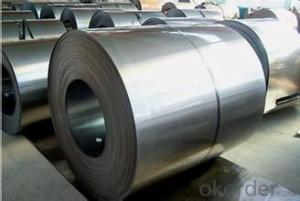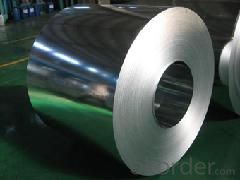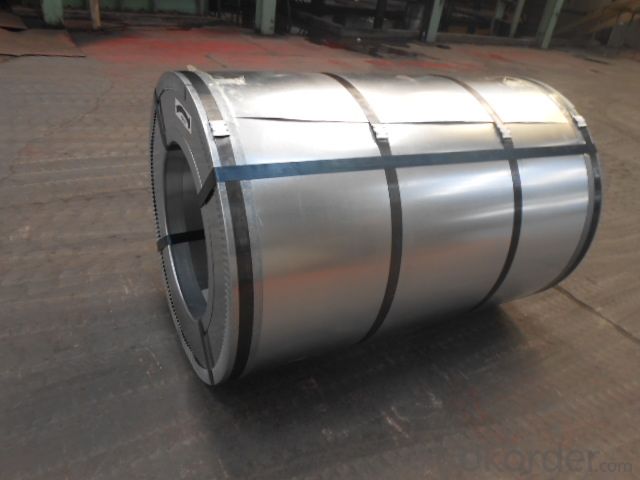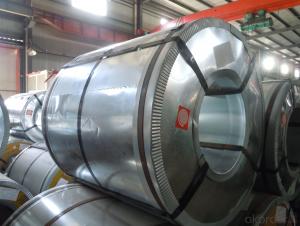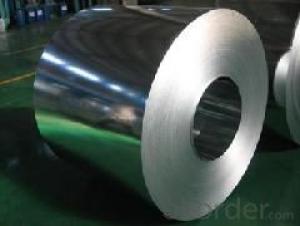Hot-Dip Galvanized Steel Coil with Best Quality of China
- Loading Port:
- Shanghai
- Payment Terms:
- TT OR LC
- Min Order Qty:
- 50 m.t.
- Supply Capability:
- 10000 m.t./month
OKorder Service Pledge
OKorder Financial Service
You Might Also Like
1. Hot-Dip Galvanized Steel Coil Description:
Hot-dip galvanized steel coil are available with a pure zinc coating through the hot-dip galvanizing process. It offers the economy, strength and formability of steel combined with the corrosion resistance of zinc. The hot-dip process is the process by which steel gets coated in layers of zinc to protect against rust. It is especially useful for countless outdoor and industrial application.
2.Main Features of the Hot-Dip Galvanized Steel Coil:
• Excellent process capability
• Smooth and flat surface
• Workability, durability
• Excellent heat resistance performance
• High strength
• Good formability
• Good visual effect
3.Hot-Dip Galvanized Steel Coil Images
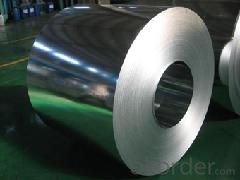

4.Hot-Dip Galvanized Steel Coil Specification
Standard: AISI, ASTM, BS, DIN, GB, JIS
Grade: SPCC, SPCD, Q195, DX51D
Thickness: 0.15-5.0mm
Model Number: coil
Type: Steel Coil
Technique: Cold Rolled
Surface Treatment: Galvanized
Application: Container Plate
Special Use: High-strength Steel Plate
Width: 600-1250mm
Length: depends
commodity: hot dipped galvanized steel coil
technique: cold rolled
thickness: 0.15-5.0mm
width: 600-1500mm
surface treatment: galvanized
zinc coating: 50-275g/m2
coil weight: 3-7 tons
coil ID: 508/610mm
spangle: zero spangle, regular spangle, small spangle, big spangle
payment term: by L/C or T/T
5.FAQ of Hot-Dip Galvanized Steel Coil
What’s the application of this product?
There are many applications for this product. For example, roofing, cladding, decking, tiles, sandwich walls, etc.
What’s the coating composition of Hot-Dip Galvanized Steel Coil?
The coating composition is 55% aluminium in weight ratio, 43.4% zinc, and 1.5% silicon, with excellent corrosion and heat resistance performance.
- Q: How are steel coils used in the production of metal fixtures?
- The production of metal fixtures relies heavily on steel coils, an indispensable element. Typically composed of carbon steel, these coils act as the primary raw material for manufacturing a diverse array of metal fixtures. To begin the process, the steel coils are initially uncoiled and subsequently cut into sheets of the desired size and thickness. These sheets serve as the fundamental material for various types of metal fixtures, including brackets, hinges, handles, and other structural components. Once the sheets have been cut, they undergo a series of shaping procedures, such as bending, stamping, or rolling. These procedures are crucial in molding the steel sheets into the specific design required for each metal fixture. For instance, bending can be utilized to create brackets or angles, while stamping can form intricate patterns or shapes. Following the shaping procedures, it is common for the steel sheets to undergo welding or joining techniques, which are employed to assemble multiple components of the metal fixture. Through welding, the various parts are securely attached, ensuring strength and durability in the final product. Moreover, steel coils also play a vital role in enhancing the appearance and extending the lifespan of metal fixtures. They can be coated or treated with protective layers, such as galvanized or powder coatings, to prevent corrosion and provide a polished finish. These coatings guarantee that the metal fixtures can withstand environmental factors and prolong their durability. To summarize, steel coils are an indispensable component in the production process of metal fixtures. They are transformed into sheets, which are then shaped, joined, and coated to create a wide range of functional and aesthetically pleasing metal fixtures utilized across various industries.
- Q: Brass as a rule I believe is betterhowever I do not plan to get into reloading any time soon I just want some cheap practice ammo so will steel case ammo hurt my gun (semi auto) any more than brass ammo and if so how much more?
- If it's new you want to use quality brass ammo the first few hundred rounds. After that it doesn't matter. But do not you cannot use brass and steel in the same session. The lacquer tends to stay behind in the chamber, will fuse with the brass and you get torn case heads. So when using steel always only use steel that session and scrub the chamber down.
- Q: What is the difference between cold rolled strip and cold rolled steel coil?
- A simple point is the difference between a strip and a volume. Strip is the flat strip of cold rolling, which is further processed on the basis of flat strip and rolled into thinner and can be rolled up,
- Q: How are steel coils cut and shaped for specific requirements?
- Steel coils are cut and shaped for specific requirements through a process called slitting and forming. Slitting involves cutting the coil into narrower strips using specialized machinery, while forming utilizes presses, rollers, or other tools to shape the steel into desired profiles. These processes allow manufacturers to tailor the dimensions and shape of the steel coils to meet specific industry and customer requirements.
- Q: What are the dimensions of steel coils used in the construction equipment industry?
- The dimensions of steel coils used in the construction equipment industry can vary, but they are typically around 48 to 72 inches in width and have an outer diameter of 60 to 80 inches. The weight of these coils can range from 5,000 to 30,000 pounds.
- Q: How are steel coils used in the production of electrical transmission poles?
- The production of electrical transmission poles relies heavily on steel coils, which are crucial for their strength and durability. These coils, made from high-quality steel, are used to create the poles' main body. They are unrolled and shaped into large cylindrical sections, which are then welded together to form the structure of the pole. This manufacturing process allows for the customization of poles in terms of length, diameter, and wall thickness to meet specific transmission requirements. The utilization of steel coils guarantees that transmission poles possess the necessary structural integrity to withstand demanding conditions such as heavy electrical conductors and environmental factors like wind, ice, and seismic activities. Steel, known for its high strength-to-weight ratio, is an ideal material for these poles as it provides the required strength while keeping the overall weight of the pole relatively low. Furthermore, steel coils also serve in the fabrication of flanges and brackets that attach to the poles. These components are essential for securing and supporting electrical conductors and insulators on the poles. By using steel coils, flanges and brackets can be manufactured with precise dimensions and strength, ensuring a secure and reliable connection between the electrical components and the transmission poles. Apart from their structural advantages, steel coils also offer excellent resistance to corrosion. This characteristic is particularly important for electrical transmission poles, which are exposed to harsh weather conditions and corrosive environments. To enhance the lifespan of the poles, steel coils are typically coated with protective layers such as zinc or epoxy to prevent rust and corrosion. To summarize, steel coils play a vital role in the production of electrical transmission poles. They are used to fabricate the main body of the poles, as well as the flanges and brackets that secure the electrical components. With their high strength, durability, and corrosion resistance, steel coils ensure that transmission poles can safely and reliably support electrical conductors for efficient electricity transmission.
- Q: What is the maximum weight capacity for a steel coil lifting device?
- The maximum weight capacity for a steel coil lifting device depends on various factors such as the design, size, and specifications of the specific lifting device. It is crucial to refer to the manufacturer's guidelines or consult with a qualified engineer to determine the exact weight capacity for a particular steel coil lifting device.
- Q: How are steel coils used in the production of structural components?
- Structural components heavily rely on steel coils throughout the production process. These coils, made from rolled steel strips, serve as the essential raw material for manufacturing various components like beams, columns, and trusses. The initial step in utilizing steel coils for structural components involves uncoiling the strip and cutting it into desired lengths. This can be achieved using diverse cutting methods, such as shearing or sawing. Once the coils are cut into appropriate lengths, they undergo further processing to shape them into specific structural components required for a particular project. One prevalent approach to shaping steel coils into structural components is through bending or forming. This necessitates the use of specialized machinery to bend or shape the steel into the desired configuration. For instance, a steel coil can be bent into an I-beam shape, commonly employed as a load-bearing component in buildings and bridges. Another technique employed for shaping steel coils into structural components is welding. This involves joining multiple steel coils together to create larger components. Welding is often employed to fabricate components like columns or trusses, which demand the combination of multiple steel coils to achieve the required strength and structural integrity. Once the steel coils have been shaped and formed into the desired structural components, they may undergo additional processes, including surface treatment or coating, to enhance their durability and resistance to corrosion. This ensures that the components will endure and withstand the demands of their intended applications. In conclusion, steel coils are crucial in manufacturing structural components as they provide the necessary raw material. Through cutting, bending, and welding processes, steel coils are transformed into the specific components needed for various construction projects. These components play a vital role in supporting the structural integrity of buildings, bridges, and other structures.
- Q: How are steel coils used in the manufacturing of pressure vessels?
- Steel coils are used in the manufacturing of pressure vessels as they are processed into flat sheets and then formed into the desired shape. These coils provide strength and durability to the pressure vessel, ensuring it can withstand high pressures and temperatures.
- Q: What are the common uses of galvanized steel coils?
- Galvanized steel coils are commonly used in various industries for their corrosion resistance and durability. They are extensively used in construction for roofing, walls, and structural components. Galvanized steel coils are also used in the automotive industry for manufacturing parts like car bodies, frames, and exhaust systems. Additionally, they find applications in the manufacturing of appliances, electrical enclosures, and agricultural equipment.
Send your message to us
Hot-Dip Galvanized Steel Coil with Best Quality of China
- Loading Port:
- Shanghai
- Payment Terms:
- TT OR LC
- Min Order Qty:
- 50 m.t.
- Supply Capability:
- 10000 m.t./month
OKorder Service Pledge
OKorder Financial Service
Similar products
Hot products
Hot Searches
Related keywords
